Haminoea
Unidentified Indo-West Pacific species
Order: CEPHALASPIDEA
Superfamily: HAMINOEOIDEA
Family: Haminoeidae
Even with a good photo of the shell it is almost impossible to name tropical Indo-West Pacific species of Haminoea with any certainty at present, especially when they are coloured with grey and brown mottling. Unfortunately, most species of Haminoea were named from empty shells, and while we have been able to sort out some species, such as Haminoea zelandiae, simply because only one species of Haminoea is found in New Zealand, the same can't be said of species which were named from parts of the tropical Indo-West Pacific.
My feeling is that the names of these tropical species of Haminoea can only be resolved by a comprehensive revision. It will need someone to look at the anatomy, external features of the living animals, and shell morphology, to find out how many species there really are, and then try and fit these 'species' with the old names and shells.
This page is for unidentified Indo-West Pacific species.
Authorship detailsRudman, W.B., 2007 (August 12) Haminoea Unidentified Indo-West Pacific species. [In] Sea Slug Forum. Australian Museum, Sydney. Available from http://www.seaslugforum.net/find/hamiiwp
Related messages
Re: Haminoea species from Townsville [2]
August 21, 2007
From: Melanie Wood
Concerning message #20462:
Hi,
I will do some 'sacrificing' at the next set of low tides and see what I can come up with!
Thank you
Mel
gizmel@yahoo.com
Wood, M. J., 2007 (Aug 21) Re: Haminoea species from Townsville [2]. [Message in] Sea Slug Forum. Australian Museum, Sydney. Available from http://www.seaslugforum.net/find/20515Thanks Mel,
Look forward to your results
Bill Rudman
Haminoea species from Townsville [2]
August 17, 2007
From: Melanie Wood
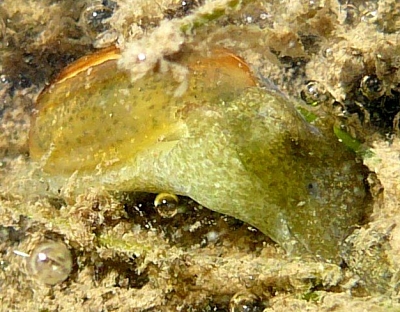
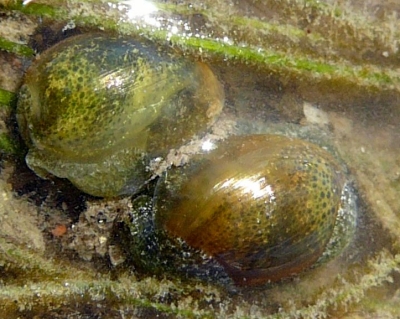
Re: message #20195
Hi,
Following my other message here are some more photos. I know that you do not like the same species to be placed together but I believe these are the same with slightly different colour variations, could you please aid in the ID?
Locality: Rowes Bay, Townsville, Low tide 0.49 metres and 0.39 metres, Queensland, Australia, 11 July 2007 and 10 August 2007, Intertidal Muddy. Length: 2 to 3 centimetres. Photographer: Melanie Wood.
Thanks
Melanie
gizmel@yahoo.com
Wood, M. J., 2007 (Aug 17) Haminoea species from Townsville [2]. [Message in] Sea Slug Forum. Australian Museum, Sydney. Available from http://www.seaslugforum.net/find/20462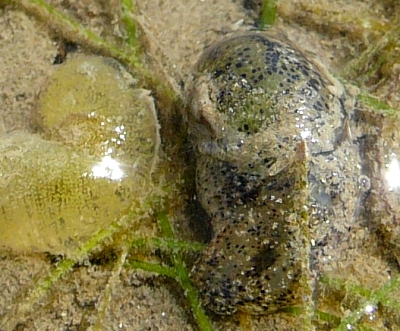
Dear Mel,
I am posting both your messages together, so you won't have seen my comments on your first message. I really can't say if the mottled animal in the top photo is the same as the black-spotted ones in the other two photos. They probably are, but I would only be guessing. Sometimes when you have two possible 'species' together, you will find noticeable differences in the shape of the shell - one may be pear-shaped whicle the other is more symmetrical etc. Its possible you can irritate the animal enough to get it to retract into its shell so you can compare then alive or perhaps you can find some dead empty shells around to compare. Failing that I am afraid the only way is to humanely kill [sacrifice?] a few animals so you can compare the shells. Because the shells are so fragile, the only way to safely remove the animal is to let it rot out by soaking it in freshwater - changing the water daily so the smell doesn't get you, and the acids in the water don't destroy the shell.
Also it would be useful to get some assistance from one of the marine research institutions in Townsville so that some photographed specimens could be preserved for future research. I am sure someone will soon want specimens. I am happy to post messages of live animals and their empty shells. I have found that shells can often be photographed well by scanning them on an ordinary scanner. Often the colour is better than using a camera. Of course depth of field can be a problem with larger specimens, but worth a try.
Best wishes,
Bill Rudman
Haminoea fusca? from Townsville, Queesnsland
August 17, 2007
From: Melanie Wood
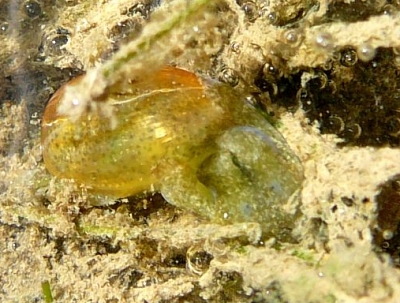
Hello,
I was tide-pooling today and I came across this species which I believe may be Haminoea fusca. There were a number of these exposed at low tide and there were also an abundance of egg masses in the same area though I am unsure whether they were from these. Quite difficult to obtain good pictures of them too!!
Locality: Rowes Bay, Townsville, Low tide (0.47metres), Queensland, Australia, 11 July 2007, Intertidal muddy area. Length: 2 cm. Photographer: Melanie Wood.
Thanks
Melanie
melanie.wood@jcu.edu.au
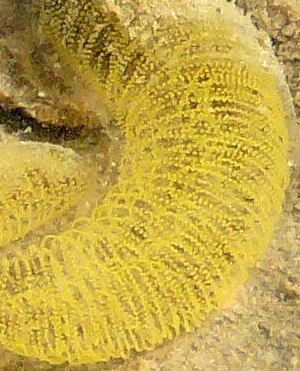
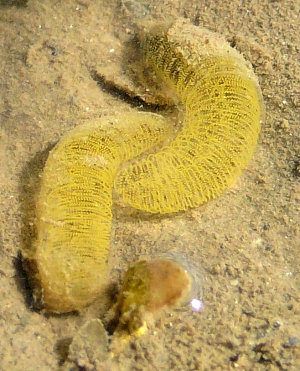
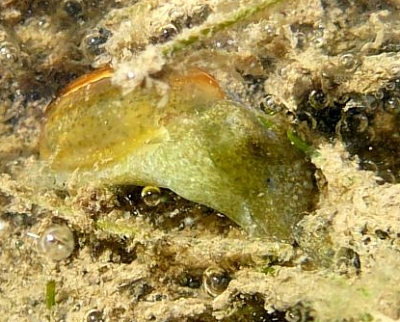
Dear Mel,
Thanks very much for the nice photos of the egg mass. It show the shape of the sausage-shaped mass and the spiral egg string very clearly.
I wish I could be more supportive of your identification. I would agree it is almost certainly a species of Haminoea, but even with a good photo of the shell it is almost impossible to name tropical Indo-West Pacific species with any certainty at present, especially when they are mottled grey and brown like this species. Unfortunately, most species of Haminoea were named from empty shells, and while we have been able to sort out some species, such as Haminoea zelandiae, simply because only one species of Haminoea is found in New Zealand, the same can't be said of species which were named from any part of the tropical Indo-West Pacific were a number of species can be present at any time. In this case, H. fusca A. Adams, was named from a shell from the Philippines.
My feeling is that the names of these tropical species of Haminoea can only be resolved by a comprehensive revision. It will need someone to look at the anatomy, external features of the living animals, and shell morphology, to find out how many species there really are, and then try and fit these 'species' with the old names and shells.
All I can really do is start up a page for unidentified Indo-West Pacific species.
Best wishes,
Bill Rudman
